Abstract
Neonates born to female guinea pigs of either a highly susceptible (C4D) or a resistant (Albany) strain, infected prior to or during pregnancy with a single dose of Treponema pallidum, showed in their sera from the first day of life immunoglobulin M (IgM) antibodies to T. pallidum, circulating immune complexes consisting of IgM antibodies and treponemal antigens, and IgM rheumatoid factor. Although the animals were asymptomatic for a 6-month observation period, several lines of evidence indicated that they were infected in utero. Molecular analysis of whole sera, purified serum IgM fraction, or dissociated immune complexes demonstrated IgM reactivity against one (47 kDa) or more of several T. pallidum peptides (15, 17, 37, 42, 45, and 87 kDa) recognized as integral membrane components. Sequential analysis of the neonates' sera by immunoblot and enzyme-linked immunosorbent assay, using alcohol-treated T. pallidum, T. phagedenis biotype Reiter, and T. vincentii, demonstrated early IgM antibodies followed 3 to 4 months later by IgG2- and IgG1-specific antibodies to T. pallidum. Moreover, an infectivity test done in five rabbits with pooled tissue extracts prepared from liveborn or stillborn animals evoked a seroconversion in two rabbits (reactive Venereal Disease Research Laboratory and fluorescent treponemal antibody tests), suggesting the presence of T. pallidum in the organs. Sera from neonates born to either T. phagedenis biotype Reiter-injected mothers or three normal pregnant females were all serologically negative. The model offers new possibilities for exploration of factors responsible for asymptomatic infection often observed in human congenital syphilis.
Full text
PDF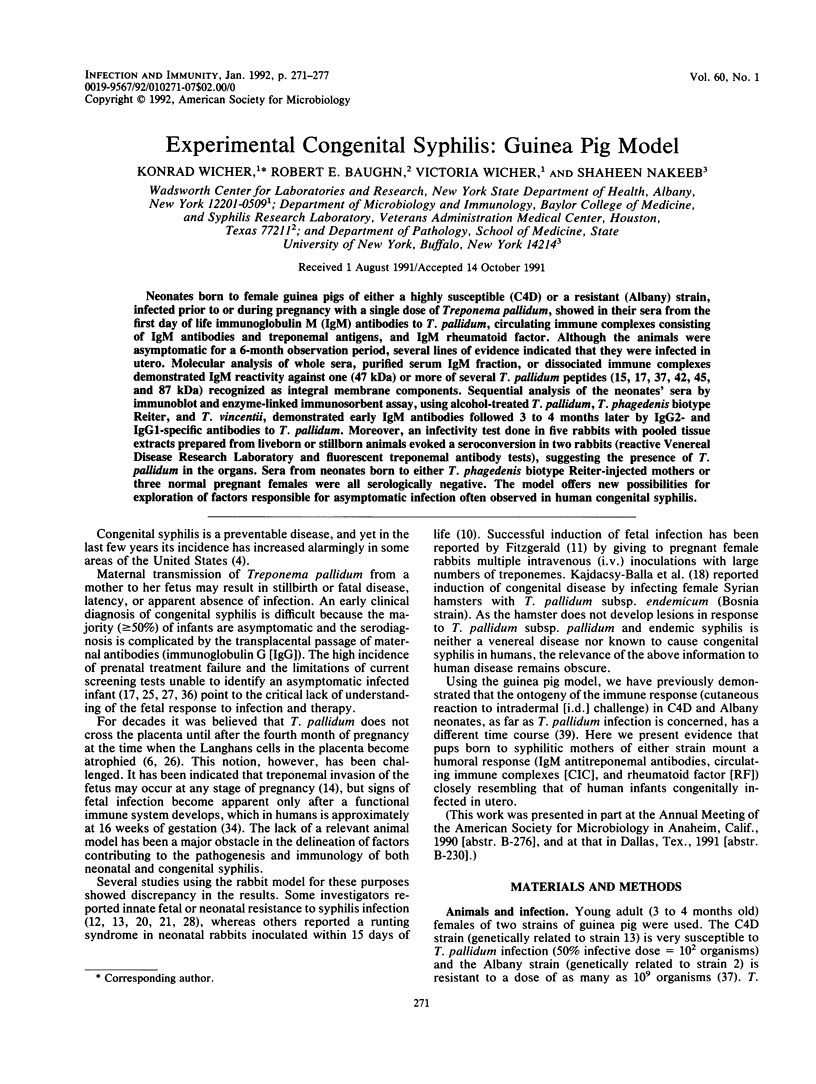
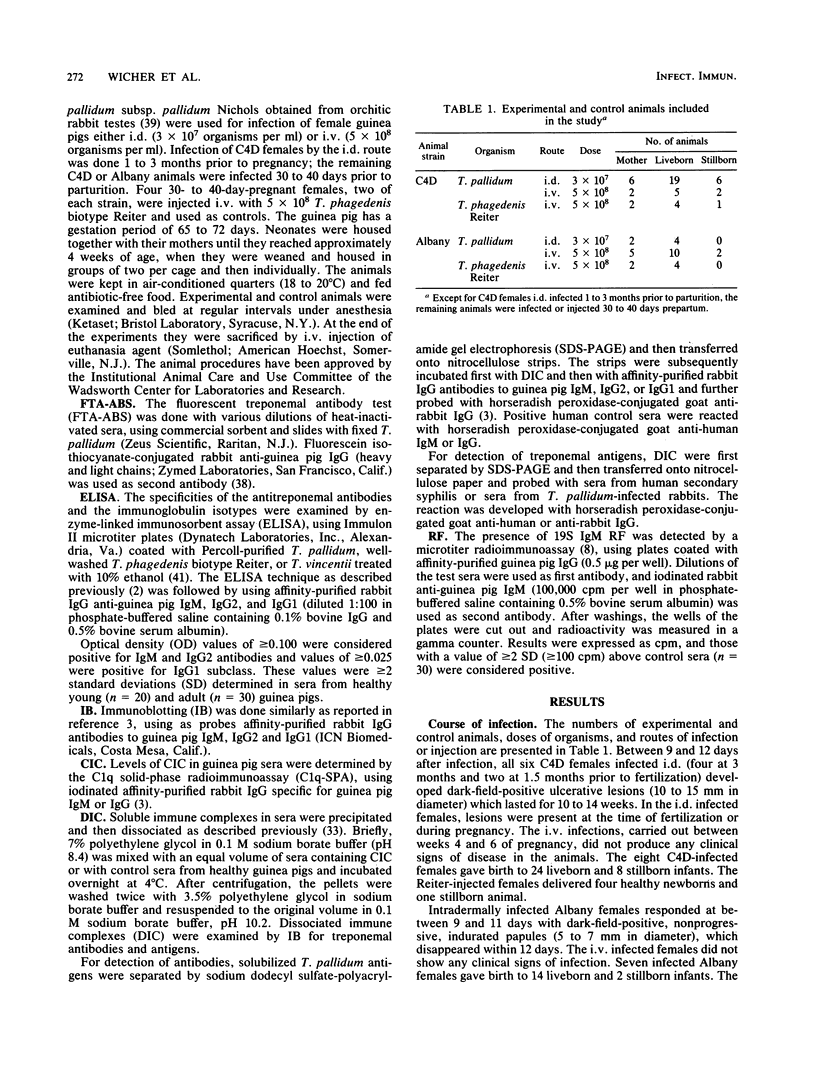

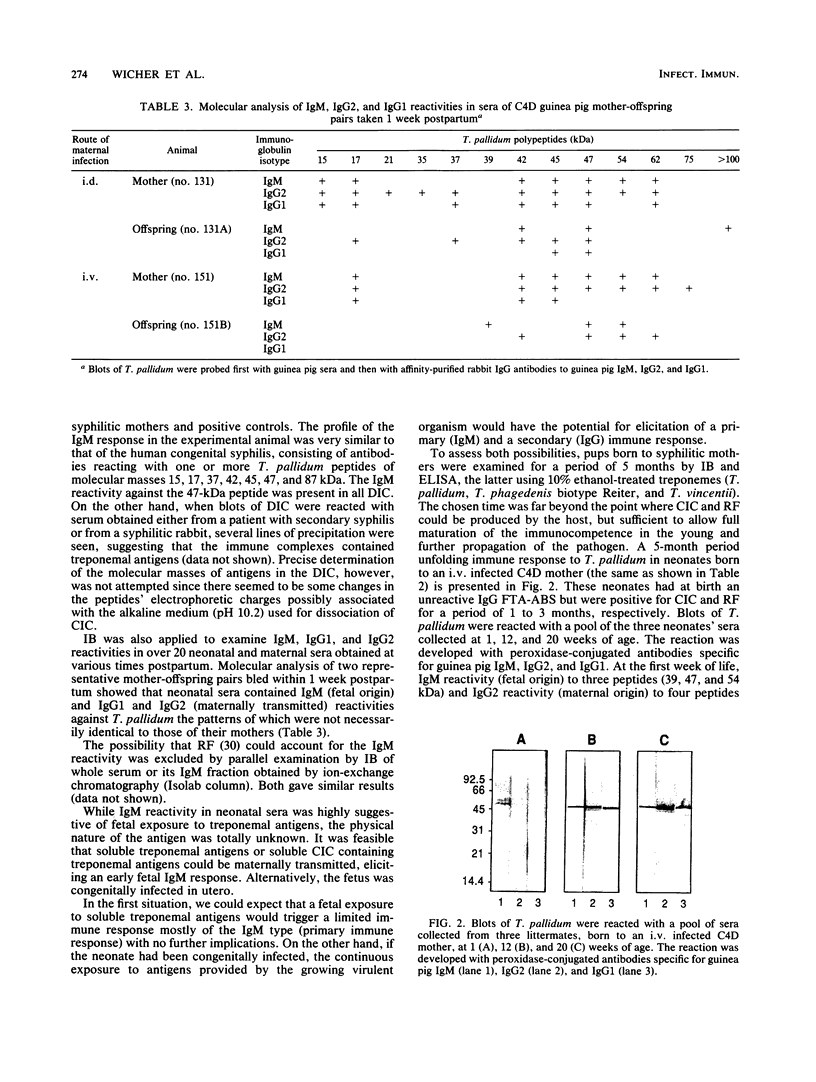
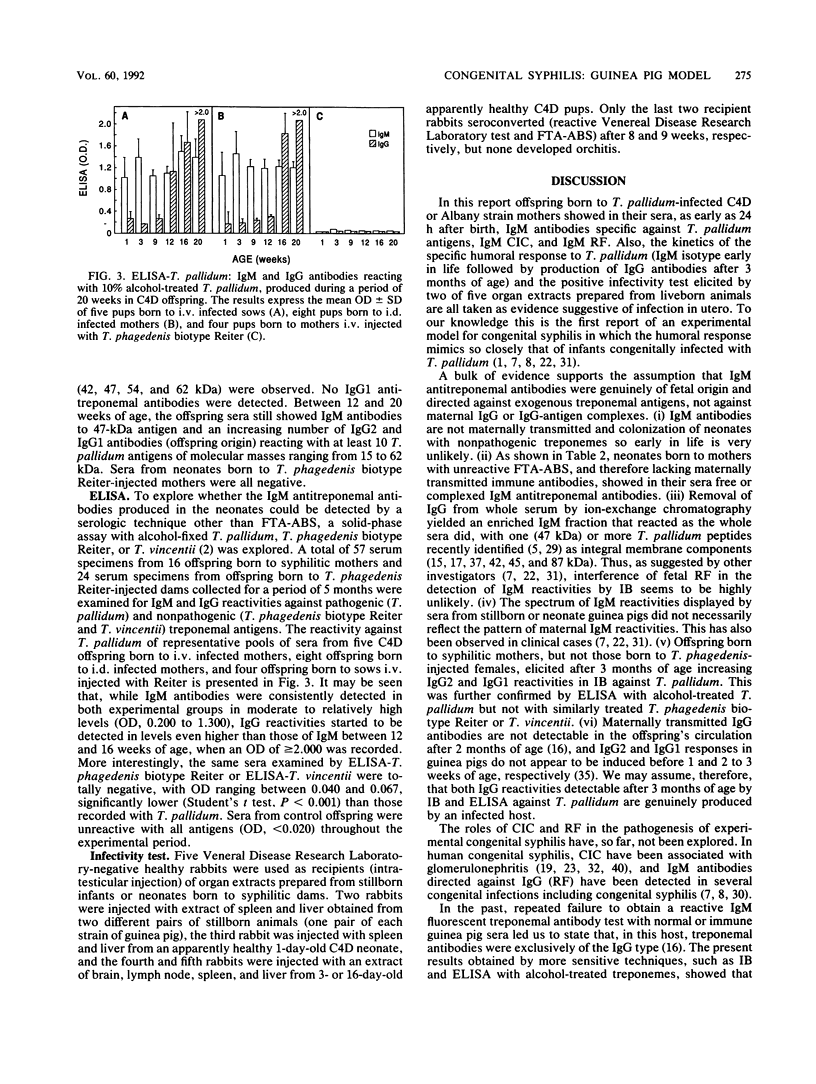
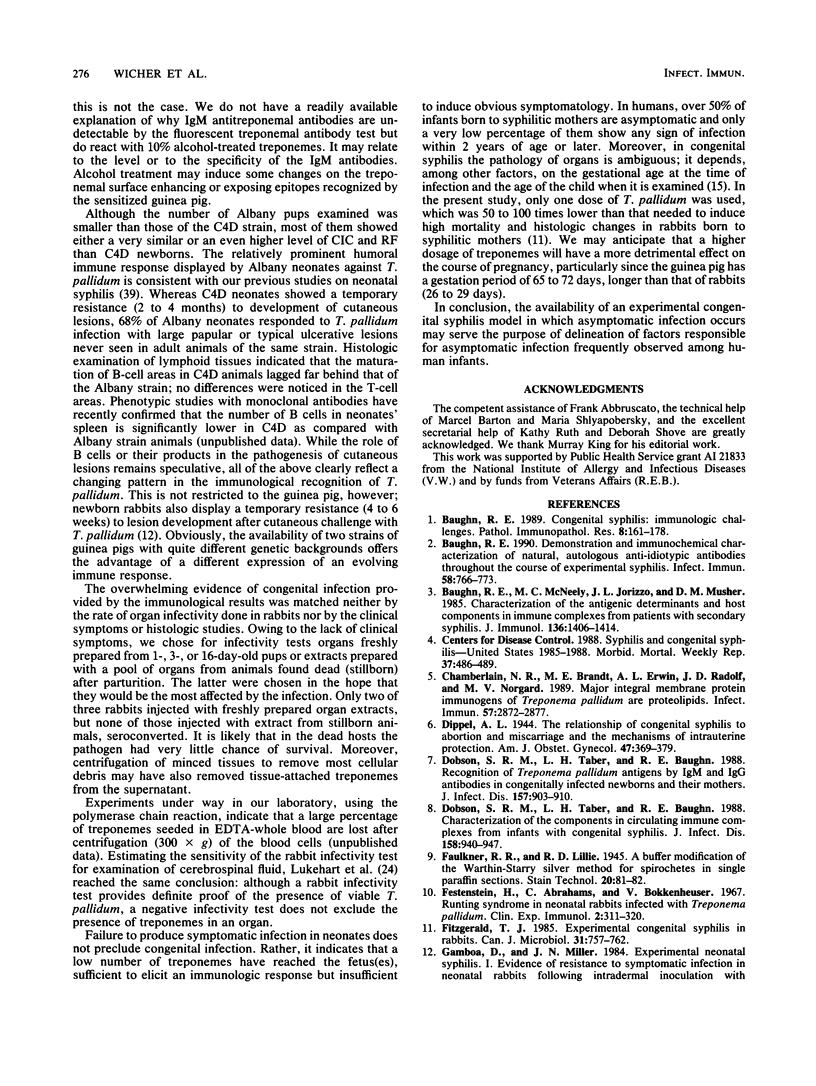
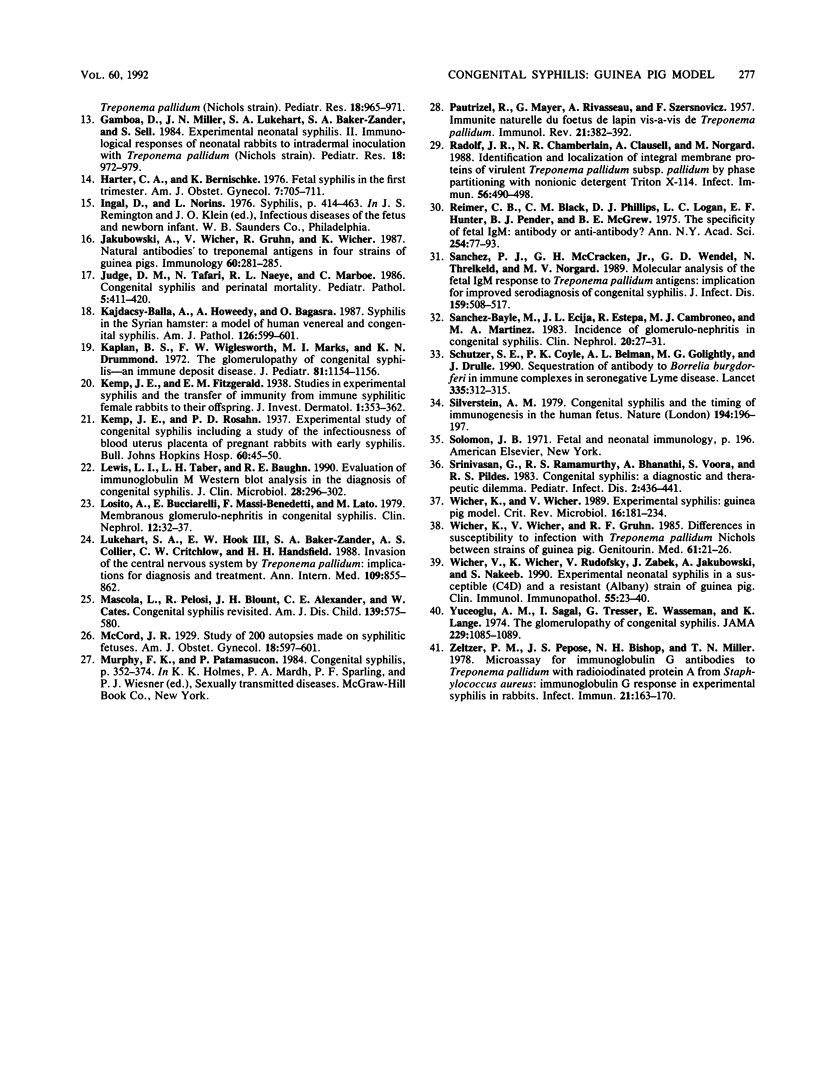
Images in this article
Selected References
These references are in PubMed. This may not be the complete list of references from this article.
- Baughn R. E. Congenital syphilis: immunologic challenges. Pathol Immunopathol Res. 1989;8(3-4):161–178. doi: 10.1159/000157147. [DOI] [PubMed] [Google Scholar]
- Baughn R. E. Demonstration and immunochemical characterization of natural, autologous anti-idiotypic antibodies throughout the course of experimental syphilis. Infect Immun. 1990 Mar;58(3):766–773. doi: 10.1128/iai.58.3.766-773.1990. [DOI] [PMC free article] [PubMed] [Google Scholar]
- Baughn R. E., McNeely M. C., Jorizzo J. L., Musher D. M. Characterization of the antigenic determinants and host components in immune complexes from patients with secondary syphilis. J Immunol. 1986 Feb 15;136(4):1406–1414. [PubMed] [Google Scholar]
- Chamberlain N. R., Brandt M. E., Erwin A. L., Radolf J. D., Norgard M. V. Major integral membrane protein immunogens of Treponema pallidum are proteolipids. Infect Immun. 1989 Sep;57(9):2872–2877. doi: 10.1128/iai.57.9.2872-2877.1989. [DOI] [PMC free article] [PubMed] [Google Scholar]
- Dobson S. R., Taber L. H., Baughn R. E. Characterization of the components in circulating immune complexes from infants with congenital syphilis. J Infect Dis. 1988 Nov;158(5):940–947. doi: 10.1093/infdis/158.5.940. [DOI] [PubMed] [Google Scholar]
- Dobson S. R., Taber L. H., Baughn R. E. Recognition of Treponema pallidum antigens by IgM and IgG antibodies in congenitally infected newborns and their mothers. J Infect Dis. 1988 May;157(5):903–910. doi: 10.1093/infdis/157.5.903. [DOI] [PubMed] [Google Scholar]
- Festenstein H., Abrahams C., Bokkenheuser V. Runting syndrome in neonatal rabbits infected with Treponema pallidum. Clin Exp Immunol. 1967 May;2(3):311–320. [PMC free article] [PubMed] [Google Scholar]
- Fitzgerald T. J. Experimental congenital syphilis in rabbits. Can J Microbiol. 1985 Sep;31(9):757–762. doi: 10.1139/m85-142. [DOI] [PubMed] [Google Scholar]
- Gamboa D., Miller J. N. Experimental neonatal syphilis. I. Evidence of resistance to symptomatic infection in neonatal rabbits following intradermal inoculation with Treponema pallidum (Nichols strain). Pediatr Res. 1984 Oct;18(10):965–971. doi: 10.1203/00006450-198410000-00012. [DOI] [PubMed] [Google Scholar]
- Gamboa D., Miller J. N., Lukehart S. A., Baker-Zander S. A., Sell S. Experimental neonatal syphilis. II. Immunological responses of neonatal rabbits to intradermal inoculation with Treponema pallidum (Nichols strain). Pediatr Res. 1984 Oct;18(10):972–979. doi: 10.1203/00006450-198410000-00013. [DOI] [PubMed] [Google Scholar]
- Harter C., Benirschke K. Fetal syphilis in the first trimester. Am J Obstet Gynecol. 1976 Apr 1;124(7):705–711. doi: 10.1016/s0002-9378(16)33340-3. [DOI] [PubMed] [Google Scholar]
- Jakubowski A., Wicher V., Gruhn R., Wicher K. Natural antibodies to treponemal antigens in four strains of guinea-pigs. Immunology. 1987 Feb;60(2):281–285. [PMC free article] [PubMed] [Google Scholar]
- Judge D. M., Tafari N., Naeye R. L., Marboe C. Congenital syphilis and perinatal mortality. Pediatr Pathol. 1986;5(3-4):411–420. doi: 10.3109/15513818609068867. [DOI] [PubMed] [Google Scholar]
- Kajdacsy-Balla A., Howeedy A., Bagasra O. Syphilis in the Syrian hamster. A model of human venereal and congenital syphilis. Am J Pathol. 1987 Mar;126(3):599–601. [PMC free article] [PubMed] [Google Scholar]
- Kaplan B. S., Wiglesworth F. W., Marks M. I., Drummond K. N. The glomerulopathy of congenital syphilis--an immune deposit disease. J Pediatr. 1972 Dec;81(6):1154–1156. doi: 10.1016/s0022-3476(72)80251-8. [DOI] [PubMed] [Google Scholar]
- Lewis L. L., Taber L. H., Baughn R. E. Evaluation of immunoglobulin M western blot analysis in the diagnosis of congenital syphilis. J Clin Microbiol. 1990 Feb;28(2):296–302. doi: 10.1128/jcm.28.2.296-302.1990. [DOI] [PMC free article] [PubMed] [Google Scholar]
- Losito A., Bucciarelli E., Massi-Benedetti F., Lato M. Membranous glomerulonephritis in congenital syphilis. Clin Nephrol. 1979 Jul;12(1):32–37. [PubMed] [Google Scholar]
- Lukehart S. A., Hook E. W., 3rd, Baker-Zander S. A., Collier A. C., Critchlow C. W., Handsfield H. H. Invasion of the central nervous system by Treponema pallidum: implications for diagnosis and treatment. Ann Intern Med. 1988 Dec 1;109(11):855–862. doi: 10.7326/0003-4819-109-11-855. [DOI] [PubMed] [Google Scholar]
- PAUTRIZEL R., MAYER G., RIVASSEAUCOUTANT A., SZERSNOVICZ F. Immunité naturelle du foetus de lapin vis-à-vis de Treponema pallidum. Rev Immunol Ther Antimicrob. 1957 Oct-Dec;21(5-6):383–392. [PubMed] [Google Scholar]
- Radolf J. D., Chamberlain N. R., Clausell A., Norgard M. V. Identification and localization of integral membrane proteins of virulent Treponema pallidum subsp. pallidum by phase partitioning with the nonionic detergent triton X-114. Infect Immun. 1988 Feb;56(2):490–498. doi: 10.1128/iai.56.2.490-498.1988. [DOI] [PMC free article] [PubMed] [Google Scholar]
- Reimer C. B., Black C. M., Phillips D. J., Logan L. C., Hunter E. F., Pender B. J., McGrew B. E. The specificity of fetal IgM: antibody or anti-antibody? Ann N Y Acad Sci. 1975 Jun 30;254:77–93. doi: 10.1111/j.1749-6632.1975.tb29159.x. [DOI] [PubMed] [Google Scholar]
- SILVERSTEIN A. M. Congenital syphilis and the timing of immunogenesis in the human foetus. Nature. 1962 Apr 14;194:196–197. doi: 10.1038/194196a0. [DOI] [PubMed] [Google Scholar]
- Sanchez-Bayle M., Ecija J. L., Estepa R., Cambronero M. J., Martinez M. A. Incidence of glomerulonephritis in congenital syphilis. Clin Nephrol. 1983 Jul;20(1):27–31. [PubMed] [Google Scholar]
- Schutzer S. E., Coyle P. K., Belman A. L., Golightly M. G., Drulle J. Sequestration of antibody to Borrelia burgdorferi in immune complexes in seronegative Lyme disease. Lancet. 1990 Feb 10;335(8685):312–315. doi: 10.1016/0140-6736(90)90606-6. [DOI] [PubMed] [Google Scholar]
- Srinivasan G., Ramamurthy R. S., Bharathi A., Voora S., Pildes R. S. Congenital syphilis: a diagnostic and therapeutic dilemma. Pediatr Infect Dis. 1983 Nov-Dec;2(6):436–441. [PubMed] [Google Scholar]
- Sánchez P. J., McCracken G. H., Jr, Wendel G. D., Olsen K., Threlkeld N., Norgard M. V. Molecular analysis of the fetal IgM response to Treponema pallidum antigens: implications for improved serodiagnosis of congenital syphilis. J Infect Dis. 1989 Mar;159(3):508–517. doi: 10.1093/infdis/159.3.508. [DOI] [PubMed] [Google Scholar]
- Wicher K., Wicher V. Experimental syphilis in guinea pig. Crit Rev Microbiol. 1989;16(3):181–234. doi: 10.3109/10408418909104471. [DOI] [PubMed] [Google Scholar]
- Wicher K., Wicher V., Gruhn R. F. Differences in susceptibility to infection with Treponema pallidum (Nichols) between five strains of guinea pig. Genitourin Med. 1985 Feb;61(1):21–26. doi: 10.1136/sti.61.1.21. [DOI] [PMC free article] [PubMed] [Google Scholar]
- Wicher V., Wicher K., Rudofsky U., Zabek J., Jakubowski A., Nakeeb S. Experimental neonatal syphilis in a susceptible (C4D) and a resistant (Albany) strain of guinea pig. Clin Immunol Immunopathol. 1990 Apr;55(1):23–40. doi: 10.1016/0090-1229(90)90066-y. [DOI] [PubMed] [Google Scholar]
- Yuceoglu A. M., Sagel I., Tresser G., Wasserman E., Lange K. The glomerulopathy of congenital syphilis. A curable immune-deposit disease. JAMA. 1974 Aug 19;229(8):1085–1089. [PubMed] [Google Scholar]
- Zeltzer P. M., Pepose J. S., Bishop N. H., Miller J. N. Microassay for immunoglobulin G antibodies to Treponema pallidum with radioiodinated protein A from staphylococcus aureus: immunoglobulin G response in experimental syphilis in rabbits. Infect Immun. 1978 Jul;21(1):163–170. doi: 10.1128/iai.21.1.163-170.1978. [DOI] [PMC free article] [PubMed] [Google Scholar]




